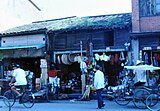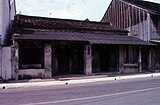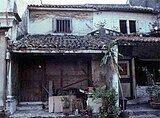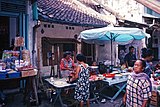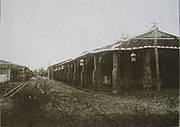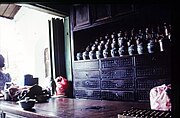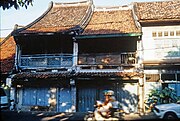Shophouse
The examples and perspective in this article deal primarily with Asia and do not represent a worldwide view of the subject. (November 2022) |

A shophouse is a building type serving both as a residence and a commercial business.[1] It is defined in the dictionary as a building type found in Southeast Asia that is "a shop opening on to the pavement and also used as the owner's residence",[2] and became a commonly used term since the 1950s.[3] Variations of the shophouse may also be found in other parts of Asia; in Southern China, Hong Kong, and Macau, it is found in a building type known as Tong lau, and in towns and cities in Sri Lanka.[4] They stand in a terraced house configuration, often fronted with arcades or colonnades, which present a unique townscape in Southeast Asia, Sri Lanka,[4] and South China.
Design and features
[edit]
- Site and plan: Shophouses were a convenient design for urban settlers, providing both a residence and small business venue. Shophouses were often designed to be narrow and deep so that many businesses can be accommodated along a street. Each building's footprint was narrow in width and long in depth. The front area along the street was formal space for customers, while the rear areas were informal spaces for family members, toilets, bathrooms, kitchens, and infrastructure.
- Veranda: Merchandise was displayed in front of the house, and was protected by a veranda from rain and sunshine. The veranda also served as reception for customers. The veranda along the street was an important area for the house owner and customers. Unless there was a communal arrangement, verandas may not connected to each other to form continuous colonnades. Where the colonnades are present by design, they form the five foot way.
- Courtyard and upper floor: Traditional shophouses may have between one and three floors. The shophouse was usually built between parallel masonry party walls. The upper part of the house was used as living quarters. To ensure air circulation, an inner "courtyard" (air-well) was placed midway between the front and rear of the house.[5]
-
Shophouse, Quanzhou, China, 1992.
-
Shophouse, Pattani, Thailand, 1992.
-
Shophouse, Melaka, Malaysia, 1992.
-
Shophouse courtyard, Melaka, Malaysia, 1990.
-
Shophouse in Pecinan, Semarang, 1991.
-
Colonial shophouses with Back Lane in George Town, Penang, 1991.
-
Shophouses line Binondo, Manila, Philippines, 1915.
Covered walkways
[edit]
In 1822, instructions were issued by Sir Stamford Raffles for the Town Plan of Singapore which specified that each house had to provide a "verandah of a certain depth, open at all times as a continued and covered passage on each side of the street".[6] Raffles' instructions created a regular and uniform townscape in Singapore with arcades or colonnades forming a continuous public pathways. Later in other Straits Settlements, the "continued covered passage" known as "five foot way" was also mandated, and it became a distinctive feature of the "Strait Settlement Style" buildings.[7][3] This feature also spread to other South East Asian countries after the mid-19th century such as Thailand and the Philippines, as well as some East Asian countries.[3]
Covered walkways are found in a building type called qilou found in Southern China, Taiwan and Hong Kong that was developed under the influence of Singaporean shophouses.[8] In Taipei at the end of the Qing dynasty period, Taiwan under the Taiwan under Japanese rule, and in Southern China under the Republic of China, similar regulations were applied, mandating a wider space.[9] In 1876, the Hong Kong colonial authority allowed the lease holder to build overhangs above the verandah (public sidewalk in Hong Kong colony) to provide more living space[10] with no intention of creating regular and uniform townscapes.
-
Passage with colonnades, Singapore, c. 1840
-
Shophouse in Hong Kong before the Verandah Regulation, O. Chadwick's Report, 1882
-
Shophouse in Hong Kong after the Verandah Regulation, c. 1905
-
Shophouses in Taipei, Taiwan, c. 1930
-
Shophouses in Sanxia, Taiwan
-
Shophouse in Jingliao, Tainan, Taiwan
Facade design
[edit]The facades of the building and sometimes the pillars may be decorated. The facade ornamentation draws inspiration from the Chinese, European, and Malay traditions, but with the European elements dominant.[11][12] European neo-classical motifs include egg-and-dart moldings, and Ionic or Corinthian capitals on decorative pilasters. The degree of a shophouse's ornamentation depended on the prosperity of its owner and the surrounding area; shophouse facades in cities and (former) boom towns are generally more elaborate than spartan rural shophouses.
Masonry-heavy Art Deco and Streamline Moderne styles eventually prevailed between the 1930s and 1950s. Modern variations through the 1950s up to the 1980s were devoid of ornamental decorations, and tended to be designed with imposing geometrical and utilitarian forms inspired by International and Brutalist styles. Beginning in the 1990s, buildings began to adopt postmodern and revival styles.[citation needed]
-
Shophouse in Singapore
-
Shophouse in Singapore
-
Shophouses in Singapore
-
Shophouses in Penang
-
Shophouses in Penang
-
Shophouses in Penang
-
Shophouse in Kuala Lumpur
-
Shophouse in Kuala Lumpur
-
Shophouses in Kuala Lumpur
-
Shophouses, Kampot, Cambodia
-
Shophouses, Kratie, Cambodia
-
Shophouses in Cho Lon, Vietnam
-
Shophouses, Paifang Street, Chaozhou
-
Zhongshan Road, Haikou
-
Shophouses, Colombo, Sri Lanka
-
Shophouses in Twatutia, Taiwan, c. 1940
-
Shophouses in Xinhua Old Street, Taiwan.
-
Shophouses in Sanxia, Taiwan
-
Shophouses in Daxi, Taiwan
-
Shophouses in Daxi, Taiwan
-
Shophouses in Daxi, Taiwan
-
Shophouse in Daxi, Taiwan
-
Shophouses in Daxi, Taiwan
-
Shophouse in Daxi, Taiwan
-
Shophouse in Twatutia, Taiwan
-
Shophouses in Twatutia, Taiwan
-
Shophouse in Lukang, Taiwan
Function
[edit]The front of the shop on the ground floor in most cases is used for commercial purposes, while the upper floors are intended for residential use.[13] The ground floor may serve as food and drink shops, offices, shops, or workshops. If the ground floor include living spaces (usually located at the back), it may be used as reception, guestrooms, and formal family rooms with ancestor altars.[citation needed] As the settlement prospered and population increased, some front shops were put to professional uses such as clinics, drugstores, law offices, pawnshops, travel agencies.[citation needed] Food and drink shops usually served economical selections, such as a variety of ready-cooked food of Chinese style, Padang style (Halal), or Siamese style. Cooking stalls rented a portion of space from the shop owner and served specific food such as fried noodles, fried rice, Indian pancakes, noodle soup. A variety of drinks was served by a different stall, sometimes by the shop owner. Such stalls have been replaced by food courts.[citation needed]
Street corners were prized as the best location for food and drink shops.[citation needed]

-
Shophouse, Pecinan, Semarang, 1991.
-
Shophouse, George Town, Malaysia, 1995.
-
Shophouse at a street corner, George Town, Malaysia, 1999.
-
Shophouse pharmacy, Glodok, Jakarta, 1991.
Modern construction
[edit]Modern shophouses are made of reinforced concrete. Loads are carried by beams and piers, built on a grid system. The spacing of the piers is determined by economic factors: wider beams require larger amounts of steel. A plot of land that measures 40 m wide and 12 m deep, could be used to create 10 shophouses, each measuring 4 m x 12 m, or eight shophouses measuring 5 m x 12 m, or something in between.
Walls are infill, which means that a row of shophouses can easily be reconfigured, to allow a business to occupy two or more shophouses, by simply removing the dividing walls.
A row of shophouses can be built in stages by exposing around 50–60 cm of rebar in the left-right beams at each end of the row. When continuing construction, new rebar is tied to the existing rebar to allow the beam to be continued, thereby removing the need for new structural piers.
-
A row of six reinforced concrete shophouses in Pekanbaru, Indonesia.
-
Row of contemporary shophouses in Tenom, Malaysia
-
1970s-era shophouses in Baliwag, Philippines.
-
Post-war modernist shophouses in Quiapo, Manila, Philippines.
-
Late 1970s mixed-use tenements in Sampaloc, Manila.
-
Brutalist shophouses beside a contemporary office block in Chatuchak District, Bangkok.
-
Renovated units in Ho Chi Minh City, Vietnam.
Singapore shophouses
[edit]The shophouses of Singapore evolved from the early-19th century during the colonial era. It was first introduced by Stamford Raffles who specified in his Town Plan for Singapore the uniformity and regularity of the building, the material used as well as features of the buildings such as a covered passageway.[6] After the colonial era, shophouses became old and dilapidated, leading to a fraction of them abandoned or razed (by demolition work or, on occasion, fire).[14]
In Singapore, the Land Acquisition Act for urban development, passed during the early-1960s and amended in 1973, affected owners of shophouses and worked a significant compensatory unfairness upon them when their shophouses were seized to satisfy redevelopment efforts.[15] Over the decades, entire blocks of historical shophouses in the urban centre were leveled for high-density developments or governmental facilities.
Owners and occupants of colonial shophouses in Malaysia underwent different experiences involving a series of rent control legislation put in place between 1956 and 1966.[16] Under the most recent 1966 Control of Rent Act, privately owned buildings constructed before 1948, including scores of shophouses, were subjected to rent price controls to alleviate housing shortages,[17] with the intent of providing the increasingly urbanised population with sufficient affordable housing. In the decades following the introduction of the act in 1966, development of sites that the shophouses rest on were often unprofitable due to poor rental takings, leading to historical urban districts stagnating but being effectively preserved, although entire blocks of shophouses were known to be demolished for a variety of reasons during the upsurge of the economy (from government acquisitions to destruction from fires). With the repeal of the act in 1997, landowners were eventually granted authority to determine rent levels and be enticed to develop or sell off pre-1948 shophouses;[17] as a result, poorer tenants were priced out and many of the buildings were extensively altered or demolished for redevelopment over the course of the 2000s and 2010s. Shophouses have also been documented to be illegally sealed for use to cultivate and harvest edible bird's nests, leading to long-term internal damage of the buildings.[18]
Many shophouses in Singapore that escaped the effects of the Land Acquisition Act have now undergone a revival of sorts, with some restored and renovated as budget hotels, tea houses, and cinemas. Some shophouses are now considered architectural landmarks and have substantially increased in value. In 2011 in Singapore, two of every three shophouse units sold for between S$1.7–5.5 million (US$1.4–4.4 million), while larger units sold for between S$10–12.5 million (US$8–10 million), a sharp increase from 2010, while average per-square-foot prices increased 21% from 2010. The median price in Singapore in 2011 was 74% higher than in 2007.[19]
-
Pre-war shophouses in Bugis's Tan Quee Lan Street.
-
Bugis Junction's glass roof provided for pre-war shophouses. February 2019.
Heritage shophouses in Malaysia
[edit]While the preservation of historic shophouses has suffered substantially in heavily developed states like Johor, Kuala Lumpur, Negeri Sembilan, Perak, and Selangor, shophouses in Malacca and Penang (which state capitals, Malacca Town and George Town, have been gazetted as UNESCO World Heritage Sites in 2008) received more care and attention due to emerging historical preservation movements in both states, experiencing similar levels of rejuvenation as in Singapore. However, the gentrification of both cities has led to older tenants of shophouses being driven out by the rising costs of renting or buying properties within historical districts. In 2012, the cost of buying a pre-World War II shophouse in George Town reached RM2,000 per square foot (US$660), equivalent to the price of the most expensive Kuala Lumpur city centre condominium units.[20]
-
Heritage shophouses in Melaka converted into guesthouse, 2008.
-
Heritage shophouses, George Town, Penang, 2008.
Indonesian shophouses
[edit]Shophouses have been very popular since the Dutch colonial period, particularly in pecinan ('Chinese quarter'). Traditional shophouses are now replaced by modern ones, called ruko (rumah toko).[citation needed]
-
Shophouses along Jalan Kramat Raya, Senen, Jakarta, 1991.
-
Ruko Development in Senen, Jakarta, 2010.
See also
[edit]- Ancestral houses of the Philippines
- Architecture of Portugal
- Architecture of Singapore
- Bahay na Bato
- Bruges merchant houses
- Chinese architecture
- Lingnan culture
- Malay houses
- Medieval Merchant's House in Southampton
- Nipa hut
- Rumah adat
- Sino-Portuguese architecture
- Strip mall in North America
- Terraced house
- Tong Lau, in Hong Kong and southern China
References
[edit]- ^ Tirapas, Chamnarn. "Bangkok Shophouse: An Approach for Quality Design Solutions" (PDF). School of Architecture and Design, King Mongkut’s University of Technology Thonburi. Retrieved 31 July 2019.
- ^ "Shophouse". Lexico. Archived from the original on 18 October 2019.
- ^ a b c Lim, Jon S.H. (1993). "The Shophouse Rafflesia: An Outline of its Malaysian Pedigree and its Subsequent Diffusion in Asia". Journal of the Royal Asiatic Society. LXVI Part 1 (1 (264)): 47–66. ISSN 0126-7353. JSTOR 41486189.
- ^ a b Kudasinghe, KSKNJ; Jayathilaka, HMLB; Gunaratne, SR. "Evolution of the Sri Lankan Shophouse: Reconsidering Shophouses for Urban Areas" (PDF). General Sir John Kotelawala Defence University. Retrieved 17 August 2020.
- ^ Zwain, Akram; Bahauddin, Azizi (1 December 2017). "The Traditional Courtyard Architectural Components of Eclectic Style Shophouses, George Town, Penang" (PDF). International Transaction Journal of Engineering, Management, & Applied Sciences & Technologies. Archived (PDF) from the original on 31 July 2019. Retrieved 31 July 2019.
- ^ a b Charles Burton Buckley (1902). An anecdotal history of old times in Singapore. Singapore, Printed by Fraser & Neave, limited. p. 84.
- ^ Mai-Lin Tjoa-Bonatz (1998). "Shophouses in Colonial Penang". Journal of the Royal Asiatic Society. LXXI Part 2 (2 (275)): 122–136. JSTOR 41493367.
- ^ Jun Zhang (2015). "Rise and Fall of the Qilou: Metamorphosis of Forms and Meanings in the Built Environment of Guangzhou" (PDF). Traditional Dwellings and Settlements Review. 26 (2): 26–40. Archived from the original (PDF) on 18 October 2015.
- ^ Izumida, Hideo; Huang, Chu Min (April 1994). "Typology of Roofed Terraces and Covered Continuous Walkways: A study on Colonial Cities and Architecture of Southeast Asia Part 2". Journal of Architecture and Planning (Transactions of AIJ) (in Japanese): 145−153. doi:10.3130/aija.59.145_2.
- ^ Izumida, Hideo (May 2003). "Settlement Improvement in the Former Hong Kong Colony According to Reports by Osbert Chadwick: A Study on colonial cities and architecture in South-east Asia Part 3". Journal of Architectural Institute of Japan: 179–186.
- ^ "Malaysia: shophouses of Georgetown, where East meets West". Minorsights.com. Archived from the original on 5 January 2017. Retrieved 13 August 2016.
- ^ Hashimah Wan Ismail (2005). Houses in Malaysia: Fusion of the East and the West. Penerbit UTM. p. 30. ISBN 9789835203626.
- ^ Chua, Beng Huat; Edwards, Norman (1992). Public space: design, use, and management. Singapore University Press. pp. 4–5. ISBN 9971-69-164-7.
- ^ Kaye, B. (1960). Upper Nankin Street, Singapore: A Sociological Study of Chinese Households Living in a Densely Populated Area. University of Malaya Press, Singapore & Oxford University Press.
- ^ Han, Sun Sheng (2005). "Global city making in Singapore: A real estate perspective" (PDF). Progress in Planning. 64 (2). Elsevier: 77–83. doi:10.1016/j.progress.2005.01.001. Archived (PDF) from the original on 14 April 2016. Retrieved 31 March 2012.
- ^ "What is the law relating to the control of rent in West (Peninsular) Malaysia?". Lawyerment.com. 31 May 2001. Archived from the original on 3 April 2015. Retrieved 5 March 2015.
- ^ a b "Why is the Control of Rent Act 1966 being repealed? Why is Control of Rent (Repeal) Act 1997 being introduced?". Lawyerment.com. 31 May 2001. Archived from the original on 2 April 2015. Retrieved 5 March 2015. Retrieved 2015-3-6
- ^ Kuar, Manjir (24 February 2011). "Unesco warns Penang on swiftlet breeding shophouses". The Star. Malaysia. Archived from the original on 2 April 2015. Retrieved 19 March 2015.
- ^ Property Guru (27 March 2012). "Shophouses increasingly popular among investors". Yahoo! News. Archived from the original on 4 April 2015. Retrieved 31 March 2012.
- ^ Wong, Johnni (21 March 2012). "Skyrocketing shophouses". The Star. Archived from the original on 5 January 2017. Retrieved 30 July 2015.
Further reading
[edit]- Chang, TC & Teo, P, "The shophouse hotel: vernacular heritage in a creative city", Urban Studies 46(2), 2009, 341–367.
- Chua Beng Huat (Chua, B.H.), "The Golden Shoe: Building Singapore's Financial District". Singapore: Urban Redevelopment Authority, 1989.
- Davis, Howard, Living Over the Store: Architecture and Local Urban Life, Routledge, 2012. ISBN 978-0415783170
- Goh, Robbie & Yeoh, Brenda, International Conference on the City, Theorizing The Southeast Asian City As Text: Urban Landscapes, Cultural Documents, And Interpretative Experiences, World Scientific Pub Co Inc., 2003. ISBN 978-9812382832
- Landow, George P. "The Shophouse: A Characteristic Singaporean Architectural Form". postcolonialweb.org. Retrieved 2012-3-30. Web article with photographs.
- Lee Ho Yin, "The Singapore Shophouse: An Anglo-Chinese Urban Vernacular", in Asia's Old Dwellings: Tradition, Resilience, and Change, ed. Ronald G. Knapp (New York: Oxford University Press), 2003, 115-134.
- Lee Kip Lim. "The Singapore House, 1849-1942". Singapore: Times, 1988.
- Ongsavangchai Nawit & Funo Shuji, "Spatial Formation And Transformation of Shophouse in the Old Chinese Quarter of Pattani, Thailand", Journal of Architecture and Planning, Transactions of AIJ, V.598, pp. 1–9, 2005. ISSN 1340-4210
- Ongsavangchai Nawit, "Formation and Transformation of Shophouses in Khlong Suan Market Town", Proceedings, Architectural Institute of Korea, 2006.
- Phuong, D. Q. & Groves, D., "Sense of Place in Hanoi's Shop-House: The Influences of Local Belief on Interior Architecture", Journal of Interior Design, 36: 1–20, 2010. doi: 10.1111/j.1939-1668.2010.01045.x
- Yeoh, Brenda, Contesting Space: Power Relationships and the Urban Built Environment in Colonial Singapore (South-East Asian Social Science Monographs), Oxford University Press, USA, 1996. ISBN 978-9676530851; Singapore University Press, 2003. ISBN 978-9971692681
External links
[edit]- "Shophouses in Singapore". ShinyVisa. 23 September 2018.
- "Shophouses of George Town, where East meets West". Minor Sights.

